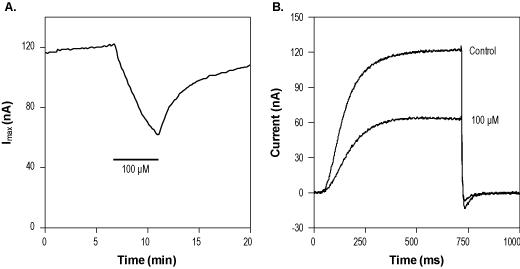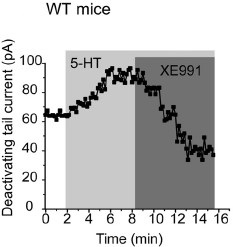Overview
- Wang, H.S. et al. (2000) Mol. Pharmacol. 57, 1218.
 Alomone Labs XE991 dihydrochloride blocks KCNQ2/KCNQ3 channels heterologously expressed in Xenopus oocytes.A. Time course of KCNQ2/KCNQ3 maximal current amplitude, elicited by 700 ms voltage step from holding potential of -100 mV to -30 mV, delivered every 10 seconds. Application of 100 µM XE991 dihydrochloride (#X-101) inhibits the KCNQ2/KCNQ3 current in a reversible manner (indicated by the horizontal bar). B. Representative current traces before and during application of 100µM XE991 dihydrocloride as indicated.
Alomone Labs XE991 dihydrochloride blocks KCNQ2/KCNQ3 channels heterologously expressed in Xenopus oocytes.A. Time course of KCNQ2/KCNQ3 maximal current amplitude, elicited by 700 ms voltage step from holding potential of -100 mV to -30 mV, delivered every 10 seconds. Application of 100 µM XE991 dihydrochloride (#X-101) inhibits the KCNQ2/KCNQ3 current in a reversible manner (indicated by the horizontal bar). B. Representative current traces before and during application of 100µM XE991 dihydrocloride as indicated.
- Yeung, S.Y. and Greenwood, I.A. (2005) Br J Pharmacol. 146, 585.
- Zaczek, R. et al. (1998) Pharmacol. Exp. Ther. 285, 724.
- Fontán-Lozano, A. et al. (2009) Hippocampus 21, 22.
Voltage-gated K+ channels of the KCNQ family (KV7) are widely expressed in nerves and smooth muscles where their general role is to hyperpolarise the cell membrane and thereby dampen excitability1.
XE991 is a potent and selective blocker of KCNQ voltage-gated K+ channels. It blocks KV7.2 + KV7.3 (KCNQ2 + KCNQ3)/M-currents (IC50 = 0.6 μM) and KV7.1 (KCNQ1) homomeric channels (IC50 = 0.75 μM) but is less potent against KV7.1/minK channels (IC50 = 11.1 μM)1. Suppression of the M-current causes an increase in intrinsic excitability2. XE991 enhances acetylcholine release from rat brain slices (EC50 = 490 nM) and shows good in vivo potency and duration of action, suggesting utility in Alzheimer’s disease therapeutics2. It was demonstrated that XE991 enhances learning and memory in healthy mice3.
XE991 dihydrochloride (#X-101) is a highly pure, synthetic, and biologically active compound.

Alomone Labs XE991 dihydrochloride inhibits KCNQ currents in mouse dorsal raphe nucleus neurons.Sample time course shows that KCNQ currents are completely blocked by 3 µM XE991 dihydrochloride (#X-101).Adapted from Zhao, C. et al. (2017) Front. Cell. Neurosci. 11, 405. with permission of Frontiers.
Applications
Citations
- Inagaki, A. et al. (2019) Pflugers Arch. 471, 313.
- Li, L. et al. (2017) Br. J. Pharmacol. 174, 4277.
- Zhao, C. et al. (2017) Front. Cell. Neurosci. 11, 405.

